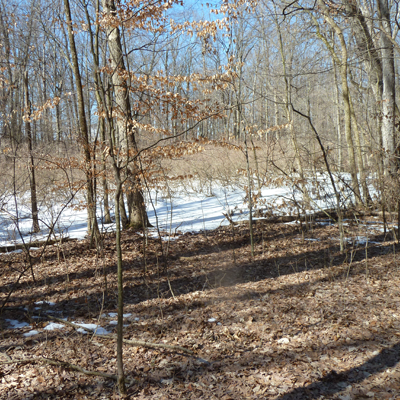As I write this article it is the last day of February and winter still has its frosted hold on the biology of central Ohio’s vernal pools. These wetlands which in just a short period of time will be teeming with life are currently lying under a cover of ice and waiting for the warmer weather of late winter to explode into action. When the time is right, the breeding runs begin. The trigger appears to be when soil temperatures on the forest floor reach or exceed those at the depths where the vernal pool salamanders are hibernating. These events, while tied to soil temperature, happen at night and are almost always paired with rain events and air temperatures near or above 50o Fahrenheit.
When all the factors come together and the conditions are ideal, large percentages of the entire population of breeding salamanders can converge on a pool in a single night. I have been at a vernal pool no bigger than a ¼ acre and have seen an estimated 3000 Spotted Salamanders swimming in the shallow water at the edges of pool and engaging in their courting behaviors. The males nudge the females in a back and forth and swirling dance of attraction, attempting to convince them to follow them forward to where the intense physical and chemical stimulation occurring in the pool has caused them to release spermatophores. These small mucusy structures in the shape of stout cones are topped with capsules of sperm and are deposited by the males on the pool substrates, most often atop last year’s fallen tree leaves. Each male will deposit many of these white colored excretions within a concentrated area of the shallow pool waters. Other males will have joined in the deposition of spermatophores and the white specks of these small structures are easy to observe through the water on the pool bottom. If a male is successful in his attempts to win the favor of a female she will follow him to this field of spermatophores and straddle one with her hind legs and pick up the sperm capsule from the top of the cone using her cloaca. This brings the sperm into her body and allows for fertilization of the eggs that are making her body bulge at her abdomen. The Spotted Salamanders are not the only creatures in the pools on these nights. Other salamanders that can be present and breeding are Smallmouthed Salamanders, Jefferson Salamanders, Eastern Tiger Salamanders and even Red-spotted Newts can be present in the pools.
All of this salamander activity in the pools is spectacle enough but it is joined by the breeding activity of their amphibian brethren, the frogs. Not only are pools rippling with acrobatics in the water, the air is also alive with the constant and sometimes deafening songs of Spring Peepers, Western Chorus Frogs, Wood Frogs, and the occasional “old man snoring” call of Leopard Frogs. In a few days the female Spotted Salamanders will deposit their eggs on twigs and other physical habitat features below the water surface. The egg masses which can contain as many as a 150 individual eggs are round and about the size of a clenched fist. The gel-like material surrounding the eggs and holding them together in masses can be clear or cloudy in color. Given the length of this year’s cold weather and the correspondingly late breeding dates for the salamanders, you can be sure when we see the salamander egg masses this year that spring cannot be far off.

